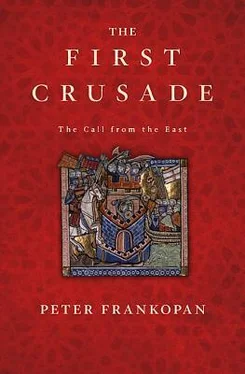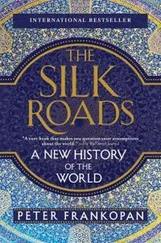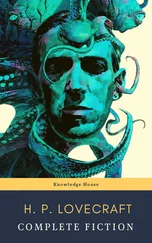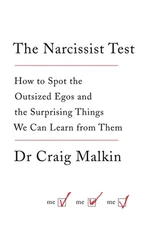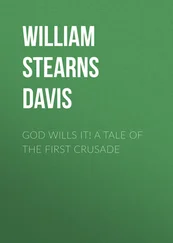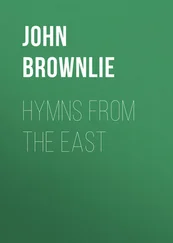Basil’s personal misgivings mask the fact that the Council of Melfi was a significant moment for rebuilding relations between Rome and Constantinople. What Basil saw as the unforgivable submission of his colleagues to take up their sees at Rossano and Santa Severina were in fact more likely to be important cases of new co-operation between the Pope and Byzantium in southern Italy. 32
Basil nevertheless took matters into his own hands. As soon as he learnt about the conciliatory moves in Constantinople, he made contact with Clement III. The antipope replied immediately. ‘Please send us quickly the letter from our holy brother the Patriarch of Constantinople which you have mentioned’, referring to the instructions Basil had been sent in order to reconcile with Rome. ‘We also must reply to him about the subject which is of such concern; he should know that everything has been duly prepared by us – for we too wish, and welcome, peace and unity.’ 33Clement reassured Basil about his own grievances, promising him that these would soon be revolved in his favour. 34Yet if Clement did try to initiate dialogue of his own with Constantinople, it did not get far. Although he had shown an interest in building bridges with the Greek church – writing to John, the Byzantine-born metropolitan, or archbishop, of Kiev to raise the prospect of closer ties with the Greek church – his overtures came to nothing. For Alexios, Urban was a more attractive ally than his German-backed counterpart. 35
For one thing, Urban still retained influence in southern Italy, a region that had been under Byzantine control for centuries until a disastrous set of reversals in the 1050s and 1060s at the hands of Norman conquerors whose power spread, according to Anna Komnene, like gangrene – ‘for gangrene, once established in a body, never rests until it has invaded and corrupted the whole of it’. 36Although the fall of Bari to the Normans in 1071 brought imperial rule of Apulia and Calabria to an ignominious end, the provinces were still home to a primarily Greek-speaking population who looked naturally to Constantinople for their lead. This link was now reactivated in the wake of rapprochement between Rome and Constantinople. Since the Norman conquest, wills, sales charters and other formal documents had carried the name of the Norman duke to date them. But from the start of the 1090s, Alexios’ name and regnal year began to appear with increasing frequency, a clear sign that the locals were looking once again to the emperor for leadership. 37The rehabilitation of Byzantium went a step further when Urban lifted the excommunication that had been passed on Alexios in 1081. 38
There were other signs of a realignment of interests between east and west. In the early 1090s, the Greek monastery of San Filippo di Fragalà benefited from a surge of favours. Several churches were placed under its authority and additional lands were granted to its community of monks by Count Roger of Sicily, who issued a decree that the monastery would be free from the interference of the Latin clergy, and from ‘the barons, the strategoi , the viscounts as well as all others’. 39And there were examples of significant co-operation elsewhere, specifically with regard to military matters. Faced with major invasions across the Balkans in the early 1090s, Alexios I sent appeals to all quarters to bolster his forces. Imperial envoys were also sent to Urban in Campania, who promptly dispatched men in the spring of 1091 to help Alexios fight Pecheneg steppe nomads who had launched a massive invasion from the Danube deep into Thrace. The subsequent battle of Lebounion, which saw the annihilation of this fearsome nomadic tribe, was one of the most important battles in the empire’s history. 40
By 1095, therefore, much had been done to heal the long-standing rift between Rome and Constantinople. Although the council proposed by Alexios a few years earlier had yet to take place, emperor and Pope had struck up a good working relationship. Indeed, if a later addition to a twelfth-century source is to be believed, together they had already developed a plan. Envoys reportedly arrived at the court of King Zvonimir of Croatia early in 1090, sent jointly by Urban and Alexios, appealing for knights to provide assistance to the beleaguered church in Byzantium and to relieve Muslim oppression in Jerusalem. If true, this was a dry run for the Pope’s appeal at Clermont: a call for help from Old and New Rome; the lure of Jerusalem; and military service as an act of devotion. In Zvonimir’s case, however, it did not have the desired effect: according to the interpolation, his knights were so appalled that Zvonimir was prepared to fight somebody else’s war that they murdered him (although other sources claim that the king died peacefully of old age). 41
By pursuing reconciliation with Constantinople, Urban deliberately positioned himself as the leader of the Christian world, which had been ravaged by years of intense competition, struggle and strife. As one contemporary chronicler put it, at the end of the eleventh century the church was in a state of chaos. ‘In all parts of Europe’, wrote Fulcher of Chartres, ‘peace, virtue and faith were brutally trampled upon by stronger men and lesser, inside the church and out. It was necessary to put an end to all these evils.’ 42Yet Urban needed a wider scheme to establish himself at the heart of Christendom. The headway he had made in his dealings with the Greek church was not enough on its own to have any wider meaning when it came to the rivalry with Clement III in Rome, let alone strengthen his position elsewhere in Europe.
In the mid-1090s, however, the situation began to change. First, sudden and unexpected developments in Germany offered an extraordinary opportunity to outflank the antipope and his chief supporter, the emperor Henry IV. Urban was boosted by high-profile defections from Henry’s camp, frustrated by the emperor’s heavy-handedness. One was Henry’s beautiful young wife, who sought out the Pope to complain that she had been forced to commit so many ‘unusual filthy acts of fornication with so many men that even her enemies would excuse her flight [from the emperor]. All Catholics should be moved to compassion because of her treatment.’ 43In a highly charged climate where the Pope’s supporters were desperate to seize on anything that could be used to discredit the emperor, sordid gossip was circulated gleefully by polemicists. 44More important still was Conrad, Henry IV’s son and heir, a serious young man who decided to renounce his father and together with his vassals offered his support to Urban, exhausted by the never-ending quarrels within the church and unsettled by doubts about his prospects as a result of military setbacks suffered by his father in northern Italy.
These developments gave the Pope an immediate and emphatic boost. Urban announced that he would hold a council in March 1095 in Piacenza, in the heart of territory previously loyal to Henry IV and in the heart of Clement III’s original archbishopric of Ravenna. With Henry’s estranged wife appearing at the council to condemn her husband, the antipope was fiercely denounced, before an amnesty was offered to all the clergy who had previously sided with the emperor. Immediately after the council, Conrad met with Urban at Cremona where he greeted the Pope by acting the part of a groom, holding the bridle of the pontiff’s horse in a ritual mark of deference and public humility. 45At a second meeting a few days later, Conrad swore an oath to protect the Pope, his office and his property. In return, Urban promised to recognise Conrad’s claim to the imperial throne. 46He also proposed a marriage between his new ally and the daughter of Count Roger of Sicily, Urban’s principal supporter in Italy. It would be much to Roger’s honour and to his future profit if a marriage was arranged, the Pope wrote to the count. The marriage was duly concluded in Pisa in splendid style, and Conrad was settled with lavish gifts from his wealthy father-in-law. 47This helped bring about a dramatic improvement in Urban’s position, taking him from an isolated figure forced to camp outside the walls of Rome to a figure of central importance in the politics of Europe.
Читать дальше
